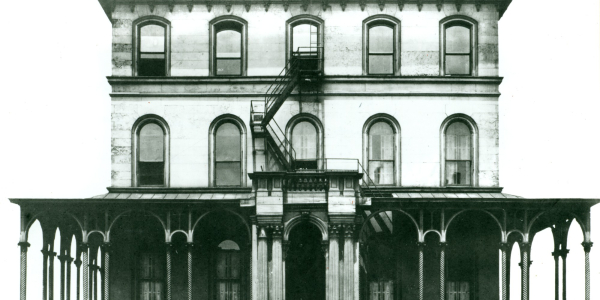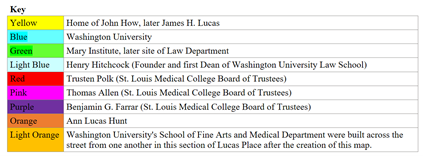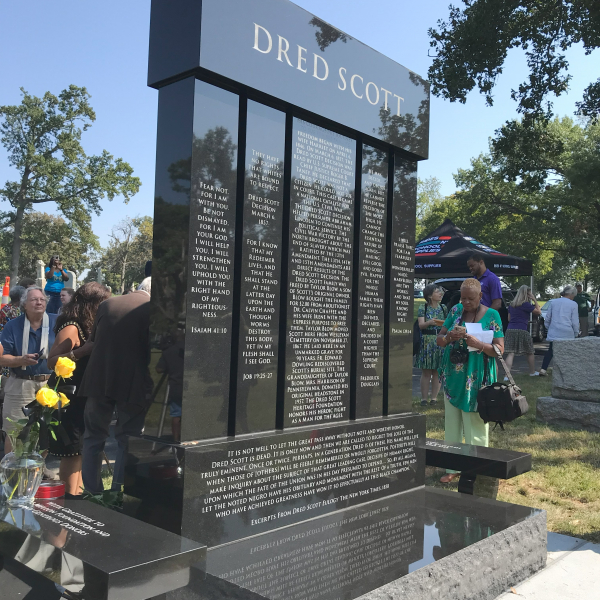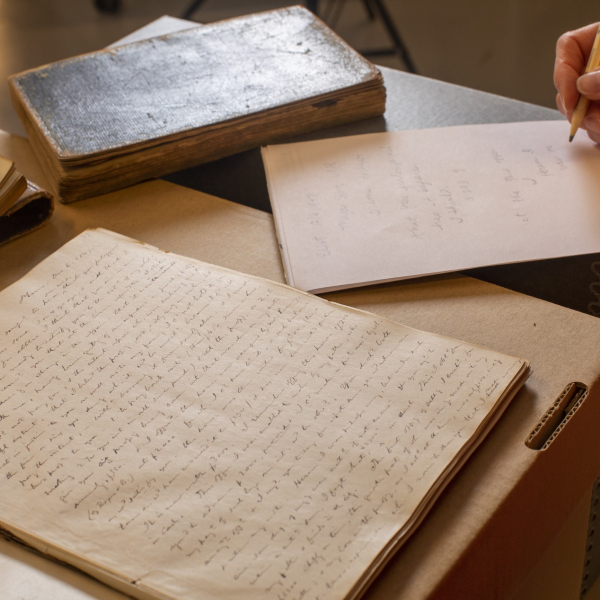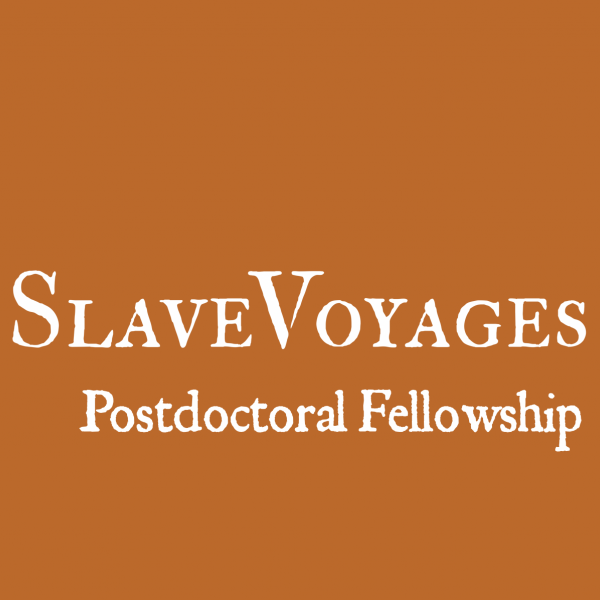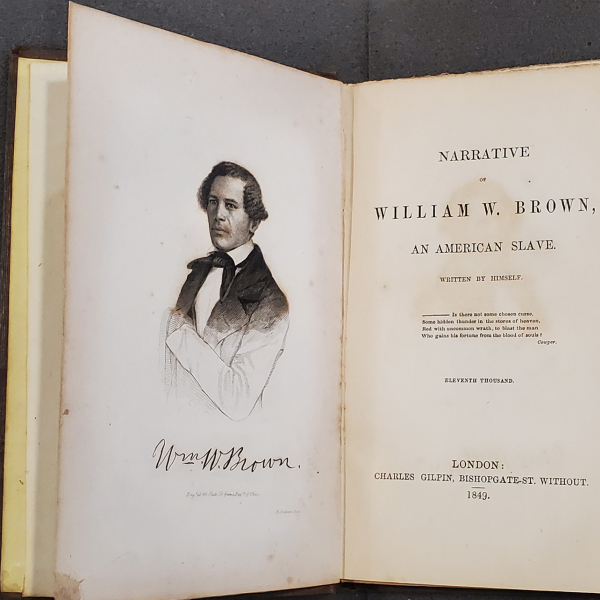James H. Lucas (1800 – 1873), an investor, lawyer, civic leader, and entrepreneur, reached the pinnacle of St. Louis’s antebellum power structure and did much to shape the city of St. Louis and early Washington University. Lucas’s prominence rested on wealth he and his family accumulated in part through labor coerced from people they enslaved directly as well as through their investment in economic markets built on slavery. The family slaveholding inheritance that contributed to Lucas’s prominence is one part of a nationwide story of generational inheritance rooted in race-based slavery that profited some while dispossessing many.
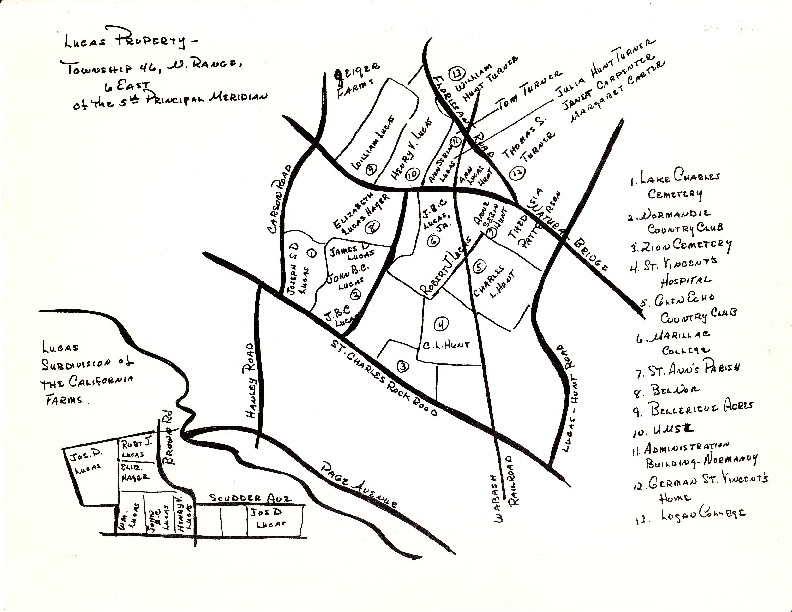
Lucas shaped Washington University in several capacities. He owned a home with a large tract of land in St. Louis, part of which he developed as a wealthy residential district called Lucas Place. Some of Lucas’s land became part of Washington University’s original downtown campus. Founder John How purchased land from Lucas for the original site of the university’s Practical Department, O’Fallon Polytechnic Institute, at Seventh and Chestnut. The university also purchased a lot on Lucas Place for the establishment of a Female Seminary, thereafter named the Mary Institute. When the St. Louis Medical College became a department of Washington University, the Medical Fund Society bought a lot for the new building at 1814 Lucas Place, where it stood “almost directly opposite the Museum and School of Fine Arts, and conveniently close to the other University buildings.” Lucas also supported the university with his wealth, pledging $500 for three years to establish an annual salary to make William Greenleaf Eliot the first official Acting Chancellor. Moreover, Lucas served as a member of the University Board of Directors, and proposed a resolution for the creation of a Law Department. Lucas is credited as one of the founders of Washington University’s School of Law, which almost bore his family name. Eliot petitioned Lucas to endow the Law School, remarking, “There would be a peculiar appropriateness in the association of your father’s name with the St. Louis Law School. He was the first U.S. Judge on this side of the Mississippi.” The Law School was never named for Lucas, however, because he did not supply the funds.

In addition to being on the Washington University Board of Directors and recognized as a founder of the Law Department, James H. Lucas was also on the original Board of Trustees for the St. Louis Medical College, alongside Washington University’s eventual founders and benefactors John O’Fallon, William Greenleaf Eliot, and James E. Yeatman. At the time, the medical college, conceived of in 1835 and established in 1842, was Saint Louis University’s Medical Department. Lucas was president of the Board of Trustees from 1843 to 1846, and was vice president from 1847 to 1855. His position likely further implicated him in the medical exploitation of enslaved people and Black bodies. According to historian Harriet Frazier, in 1835, just before Missouri’s first medical colleges were founded, the state legalized “an already existing practice” by permitting the dissection of the dead bodies of enslaved people, in addition to the cadavers of executed criminals, for educational purposes. Indeed, when a mob of rioters influenced by the anti-Catholic, anti-immigrant Know Nothing Party stormed the St. Louis Medical College in 1844 after a pile of dissected corpses had been discovered lying exposed there, the bodies of Black adults and children were reported to have been strewn throughout the heap. The riot contributed to the closure of Saint Louis Medical College and its formal separation from Saint Louis University, after which it became the independent Saint Louis Medical College in 1855. Later, on April 14, 1891, this St. Louis Medical School affiliated with Washington University and was established as its medical department.
Lucas’s ability to become one of St. Louis’s wealthy, leading elite came from his slaveholding inheritance. His father, John Baptiste Charles Lucas, a native of France who migrated to Pennsylvania (where James H. was born), had served as a member of the U.S. House of Representatives and later moved to St. Louis in 1805, becoming a member of the city’s French Catholic slaveholding aristocracy. In January 1807, when John Baptiste Charles Lucas submitted his resignation as Commissioner of Lands to the Secretary of the Treasury, he remarked, “St. Louis is a very expensive place and I wish to retire on a plantation as soon as possible.” In his quest to buy a farm, he also sought to acquire enslaved people. Lucas tasked William C. Carr to help him do so, who wrote to Lucas from Lexington, Kentucky, in July 1810, informing him, “I have made every enquiry in my power on the subject of purchasing negroes in this country since my arrival & ... that I was correct in stating to you at Ste. Genevieve they were dear. I am informed you will not be able to purchase any tolerably good negro man for less than $500. unless it be in some case of very great emergency: none of which are within my knowledge at this time. Slaves are brought in great numbers here from the Eastern and Southern states to labor in the different factories established in Kentucky: and the demand for them is yet very great. This of course keeps up the price. If however you should want one with his wife and two small children I think I know of such that might be purchased much below their value and that are said to be exceeding fine slaves.” Despite Carr’s stated scarcity of bonded laborers, Lucas proceeded to obtain more enslaved people. By September of the same year, J.B.C. Lucas had acquired 25-year-old Kayer from Richard Lowe of St. Charles, Missouri, for $450.
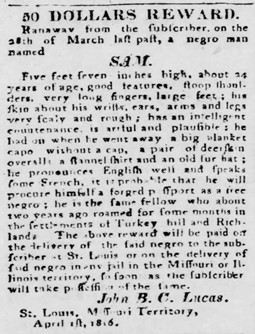
Missouri Gazette offering a reward
for Sam's capture, May 4, 1816.
Over the next few decades, Lucas’s possession of enslaved people grew, as did his wealth and influence. But his bondspeople found ways to challenge his ownership over them. Sam, who Lucas enslaved, made multiple attempts to escape his bondage, but was often impeded. In about 1813 he fled southwest and spent several months moving about near the settlements of Turkey Hill and Richland, Missouri. On December 22, 1815, he set out again to seek his freedom by leaving Lucas’s property. The reward notice Lucas posted for Sam’s capture suggests that Sam drew upon many skills and resources he acquired in Missouri territory to get away and convince others he was a free man: “[He] has an intelligent appearance, is artful and plausible; he had on when he went away, a Big blanket Cape without a cap, a new pair of deer skin overalls, a pair of good strong shoes, and an old fur hat. He pronounces English well and speaks some French: it is probable that he has procured himself a forged pass as a free negro. He is the same fellow who roamed about two years ago in the settlement of Turkey hill and Richlands, for several months.” It appears that between late January and March of 1816, Sam was indeed found and forced back into slavery, for Lucas wrote another advertisement for Sam’s apprehension on April 1, 1816, which was published in the Missouri Gazette on May 4, stating that Sam had escaped on March 28. Though much of the language of this advertisement reflected the previous one, Lucas, perhaps out of a sense of desperation to recapture Sam, increased the reward for Sam’s capture from $25 to $50, and added to his request for Sam’s delivery in St. Louis that a captor could also hand Sam over to “any jail in the Missouri or Illinois territory.” It is not yet known whether Sam was forced back into slavery again or managed to preserve his freedom.
Pauline (known as Polly or in French as Pollé), who was enslaved to Lucas along with her children, found an alternative way to secure freedom that allowed her to remain in place and limit the risk of being severed from her children. While enslaved to Lucas, Pauline had a son named Joseph, who was baptized in the Old Cathedral of Saint Louis on November 1, 1818. Pollé had another son, Leon, on January 15, 1821, who was baptized in the Cathedral July 26. It is possible that John B. C. Lucas was the father of Polly’s children. Polly may have used these circumstances to negotiate for her freedom and have Lucas provide for her and her family. On May 4, 1839, Polly obtained her freedom from Lucas, but she continued to live with him when the 1840 census was recorded, her son Leon still enslaved to Lucas. And when Lucas drafted his will before his death in 1842, he stipulated that his son James H. ensure “the payment of an annuity of one hundred and fifty dollars annually to be paid to Polly formerly my slave who is now free, as hereinafter provided for.”

James H. Lucas, and directs that Polly be provided for after his death.
James H. Lucas’s upbringing was shaped by the slaveholding milieu of his father, the society in which he lived, and his family’s Catholic slaveholding network. Even when he left his family’s home to attend St. Thomas College in Nelson County, Kentucky from 1814 to 1817 (overlapping for a year with classmate Jefferson Davis), he continued to benefit from slavery. Enslaved people supported the college with their labor from its founding in 1811 until slavery’s abolition in 1865.
Lucas and his sister Ann Lucas Hunt inherited their father’s slaveholding estate in 1837. That year, James H. and his family settled on “The Farm,” the 50-acre family plantation valued at $30,000 given to him by his father. Lucas’s slaveholding inheritance enabled his prominence and influence in St. Louis. As one account of the Lucas family emphasizes, “From 1837, James H. Lucas is identified with the progress of St. Louis and its growth in wealth and prosperity.” He was a state senator from 1834 to 1845 and ran for mayor of St. Louis in 1847 but was not elected. As Lucas’s influence grew, so too did his slaveholding. In 1840, he held seven people in slavery. By 1850, Lucas held seven people in slavery at his downtown St. Louis residence alone, and sixteen more people on his inherited Normandy plantation (now Normandy, Missouri). A baptism record from St. Ferdinand Church in Florissant reveals that on March 8, 1855, George and Pauley, a couple who labored in slavery at Lucas’s Normandy plantation, had a daughter named Fanny, who was baptized March 8, 1855. In 1860, Lucas held seventeen people in bondage at his downtown home.
James H. Lucas and his family engaged in slaveholding and trading in network with the state and church institutions for which they were benefactors. Their wealth, derived in part through slavery, contributed largely to the growth of the state and the local Catholic church. Ann Lucas Hunt, James’s sister, and her husband Theodore Hunt, held Jean, Marie Agy, Jean, Mary, Charles, Fillia, and Maria in slavery according to cathedral baptism records. Ann Hunt gave several pieces of property for the construction of Catholic institutions, including Saint Francis Xavier parish school for girls, the Convent of the Good Shepherd, and Saint Ann Church in Normandy. Hunt gave half a block of land for the construction of Our Lady of Victories Church, while Bishop Peter Richard Kenrick bought the other half from James H. Lucas in the early 1840s. Later the same decade, Lucas purchased Mary Hoppins Hawkins, the widow of Gabriel Hawkins, who was enslaved to the Society of Jesus (or Jesuits), from Major Sarbordi. When Augustine Queen, another man enslaved to the Jesuits who ran Saint Louis University, where James H. Lucas was a Medical College Trustee, asked to marry her, Lucas opposed the arrangement. Mary and Augustine were not permitted to wed of their own free will—they had to obtain the consent of their owners, and Lucas’s initial reluctance proved an obstacle. Ultimately, likely at Augustine’s and Mary’s insistence, they and the Jesuits convince Lucas to allow Mary to marry Augustine and be purchased. By 1849, Jesuit John Anthony Elet at Saint Louis University sent Augustine to Jesuit John Baptist Smedts at the Jesuits’ St. Stanislaus Seminary and Farm in Florissant, Missouri, carrying a note that read, “The bearer of this note, Gustin, yr coloured carpenter, may be, and is hereby permitted, to marry Mary, Gabe’s widow, all difficulties on the part of Mr. Js Lucas having been removed. Mary will be permitted to stay where she is at present until she asks herself to be removed. At any time she wishes to be sold to us, & we are prepared to buy her, she may be purchased.” Not only did their respective owners require Mary Hoppins Hawkins and Augustine Queen to obtain permission to marry, they were only able to stay together due to the consent of their owners. Mary and Augustine married on February 17, 1849, but the Jesuits of Saint Louis University were not able to officially purchase Mary until after Lucas had sold her to Colonel Henry Bainbridge at Jefferson Barracks, using $600 the order had acquired from selling Peter Queen, likely Augustine’s brother, away from his wife and children as a punishment for resisting his bondage.
As sectional tensions heightened in the late antebellum period and the prospect of civil war loomed, a growing number of enslaved people took the opportunity to obtain freedom. Slavery in the city was becoming less profitable, and enslavers found it more economically advantageous to hire enslaved people out to labor for others in exchange for pay. Many enslaved people were able to negotiate with their enslavers for a portion of this pay, while others hired themselves out in their own free time and at night. Several used the income they collected to negotiate to buy and protect their freedom. This may have been what some of the people enslaved to Lucas did in the late 1840s and 1850s. The approximately 23-year-old Leo Lucas (who was likely the same person as Leon, the son of Pauline, born in 1821), obtained his freedom by 1846. And Manette, about 38 years old, was able to arrange for the emancipation of herself and her daughters Lizzy, age 10, and Theresa, age 7, from James H. Lucas on April 26, 1856.

registered in the St. Louis Circuit Court Saturday, April 26, 1856.
Even when legally free, the people Lucas had once enslaved found that their hold on freedom was tenuous. Many enslaved St. Louisans likely purchased their freedom or negotiated for freedom as a reward from their enslaver for a particular form of service or “good behavior.” But the price for this freedom and the legal record of their emancipation was not enough to guarantee they could continue to live safely in freedom in St. Louis. The Missouri General Assembly established in 1834 that to continue living in the city, Black St. Louisans were required to have a freedom license proving their free status, financial stability, employment, and good behavior. In 1843, seeking to restrict free Black St. Louisans even further, the General Assembly passed, “An Act more effectually to prevent free persons of color from entering into the State, and for other purposes.” The act required free African Americans to pay a prohibitively expensive bond of between $100 and $1,000 (typically $500), and have a security (sometimes a former enslaver, a current employer, or a free family member or neighbor willing to risk their reputation and pay the bond if the person on the license was convicted of a crime) attest to their good behavior in order to have a freedom license enabling them to remain in the state.
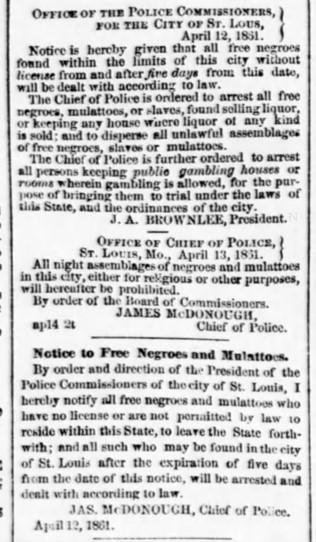
Leo Lucas, now free and working as a laborer, obtained his freedom license for a bond of $100 on December 29, 1846, with James H. Lucas as security. Due to their expense (bonds ranged between about $3,000 and $38,000 in today’s dollars), many free Black St. Louisans, especially those who may have just used most of their funds to purchase or sue for their freedom, could not afford the bond and attempted to live without it until they were able to obtain it, or until a threat to their freedom put them in danger of enslavement or re-enslavement. One such risk occurred after the firing on Fort Sumter on April 12, 1861 that precipitated the Civil War. As white men in St. Louis formed pro-union and pro-secession organizations, pro-slavery sympathizers gained control of the Missouri state assembly, replacing the Saint Louis Police Force with a Board of Police Commissioners consisting of supporters of secession. The Police Board threatened to arrest and prosecute any Black person found without a license. In fear of being forced back into slavery, 349 Black Saint Louisans rushed to obtain freedom licenses between April 15 and April 29. Manette and her children Elizabeth (age 15) and Francis (age 11) were among them, filing for licenses on April 20—nearly five years after securing their emancipation—with James H. Lucas standing as their security. George Puckett obtained his license on the same day, his certificate also naming James H. Lucas as security. The licenses reveal how Manette and George Puckett, both age 45, were employing themselves in freedom. Manette supported her children as a washer, while George Puckett was a steamboat fireman.
James H. Lucas was a founder, funder, and leader of several St. Louis institutions, including Washington University, using wealth he and his family accumulated by holding people in bondage and investing in an economy of slavery. When histories of Lucas and his family have proclaimed such things as, “James’ deep concern for the welfare of St. Louis paved the path for his conspicuous and leading part in giving of money and time to promote the welfare and prosperity of St. Louis,” and “James H. contributed wisely and largely to enrich and beautify the city,” they have failed to acknowledge that as he gave so freely of his wealth to benefit St. Louis, he was accumulating wealth from the inheritances, unrecompensed labor, and buying and selling, of people he claimed to own, as well as through institutional and financial entanglements with slavery, such as through his investment in banking and railroads. Lucas’s story also helps us see how many higher education and other institutions in St. Louis grew entangled with the history and legacy of slavery. Lucas’s portrayal as a “self-made” benevolent man is inaccurate not only because it omits his exploitation of enslaved people, but because he operated in a web of institutional relationships which profited from slavery. These institutional histories are not mutually exclusive; they’re bound up within one another. Slavery did not operate as a monolith separate from the operations of society—as Lucas’s own ties and the lives of the people he enslaved show, it is tangled up with businesses, urban development, neighborhood histories, churches, and higher education institutions. The story of Lucas and his family must also acknowledge these entanglements with slavery, as well as the many ways the people they held in bondage resisted their enslavement and pursued freedom.
Last updated March 2, 2022
Recommended Citation
Kelly L. Schmidt, “James H. Lucas and the Inheritances of Slavery,” WashU & Slavery Project, 2022.
Sources
“1830 United States Federal Census [St Louis, St Louis, Missouri].” National Archives and Records Administration, 1830. 72 (roll M19). National Archives and Records Administration, Washington, D.C.
“1840 United States Federal Census [St Louis, Saint Louis, Missouri].” National Archives and Records Administration, 1840. Ancestry.com.
“1850 U.S. Federal Census - Slave Schedules,” 1850. Records of the Bureau of the Census. National Archives and Records Administration, Washington, D.C.
“1860 U.S. Federal Census - Slave Schedules,” 1860. Records of the Bureau of the Census. National Archives and Records Administration, Washington, D.C.
Gateway Arch National Park (U.S. National Park Service). “African-American Life in St. Louis, 1804-1865 From the Records of St. Louis’ Courts,” April 10, 2015. https://www.nps.gov/jeff/learn/historyculture/african-american-life-in-s....
“Baptism Records, 1855-1899.” St. Ferdinand Parish. Archdiocese of St. Louis Office of Archives and Records.
“Baptisms, 1835-1844,” Old Cathedral of Saint Louis.
“Bill of Sale of Mary,” October 28, 1850. Box 3.0223, folder 7 - Slavery 1850, 1862, 1872. Saint Louis University Collection, MIS 3.002. Jesuit Archives and Research Center, St. Louis, Missouri.
Carr, William C. Letter to John B. C. Lucas, July 7, 1810. John B. C. Lucas Papers. Missouri History Library.
“Consultors Meeting Minutes for the Missouri Vice Province,” 1832-1865. Missouri Province Collection. Jesuit Archives and Research Center, St. Louis, Missouri.
“Day Book Volume 4,” 1848-1854. Box 3.0143, volume 4. St. Stanislaus Collection. Jesuit Archives and Research Center, St. Louis, Missouri.
Elet, John Anthony. Letter to John Baptist Smedts, n.d. John Anthony Elet Personnel File. Jesuit Archives and Research Center, St. Louis, Missouri.
Gateway Arch National Park (U.S. National Park Service). “Emancipations,” April 10, 2015. https://www.nps.gov/jeff/learn/historyculture/emancipations.htm.
Faherty, William Barnaby. Dream By The River. St. Louis, 1973.
Frazier, Harriet C. Slavery and Crime in Missouri, 1773-1865. Jefferson, N.C.: McFarland, 2001.
“Free Negro Bond for George Puckett,” April 20, 1861. Missouri History Library. http://repository.wustl.edu/concern/texts/3j333374v.
“Free Negro Bond for Leo Lucas,” December 29, 1846. Missouri History Library. http://repository.wustl.edu/concern/texts/wh246t736.
“Free Negro Bond for Manette,” April 20, 1861. Missouri History Library. http://repository.wustl.edu/concern/texts/7s75dd853.
Free Negroes: An act more effectually to prevent free persons of color from entering into the State, and for other purposes, § 12 (1843).
“General Charge and Discharge Book, 1831-1881,” Box 3.0145, volume 1. St. Stanislaus Collection. Jesuit Archives and Research Center, St. Louis, Missouri.
“General Charge and Discharge Book and Ledger of the House of St. Stanislaus,” 1838-1868. Bin 3.0145, volume 3. St. Stanislaus Collection. Jesuit Archives and Research Center, St. Louis, Missouri.
Gollar, C. Walker. “Jesuit Education and Slavery in Kentucky, 1832—1868.” The Register of the Kentucky Historical Society 108, no. 3 (2010): 213–49.
Jenkins, Ebony. “Freedom Licenses in St. Louis City and County, 1835-1865.” Gateway Arch National Park: National Park Service, 2015. https://www.nps.gov/jeff/learn/historyculture/loader.cfm?csModule=securi....
Jones, John. Letter to James Gordon Bennett, February 25, 1844. Missouri History Library.
Kennington, Kelly M. In the Shadow of Dred Scott: St. Louis Freedom Suits and the Legal Culture of Slavery in Antebellum America. University of Georgia Press, 2017.
Langedorf, Alexander S. History of Washington University, 1853-1953. St. Louis, 1954.
“Ledger of Saint Stanislaus House, 1840-1857,” Box 3.0146, volume 1. St. Stanislaus Collection. Jesuit Archives and Research Center, St. Louis, Missouri.
“Ledger of the Missouri Mission, 1836-1851,” Box 2.0157, volume 5. Office of the Treasurer Collection, Missouri Province Archive. Jesuit Archives and Research Center, St. Louis, Missouri.
Lowe, Richard. “Bill of Sale for Kayer,” September 26, 1810. John B. C. Lucas Papers. Missouri History Library.
Lucas, John B. C. “25 Dollar Reward,” December 29, 1815. John B. C. Lucas Papers. Missouri History Library.
———. “25 Dollars Reward.” Missouri Gazette and Public Advertiser. January 13, 1816.
———. “50 Dollars Reward.” Missouri Gazette and Public Advertiser. May 4, 1816.
———. Letter to Secretary of the Treasury, January 29, 1807. John B. C. Lucas Papers. Missouri History Library.
“Monastery of St Thomas.” In 1830 United States Federal Census [Eastern District, Nelson, Kentucky], 40 (roll M19). National Archives and Records Administration, 1830.
Negroes and Mulattoes: An act concerning free negroes and mulattoes, § 8 (1835).
“Old Cathedral Baptisms, 1814-1823,” 1823 1814. Old Cathedral of St. Louis.
“Register of Marriages, 1813-1862; Register of Burials, 1822-1876,” Box 3.0373, item 38. Saint Ferdinand Parish Collection. Jesuit Archives and Research Center, St. Louis, Missouri.
Romeo, Sharon. Gender and the Jubilee: Black Freedom and the Reconstruction of Citizenship in Civil War Missouri. Electronic resource. Studies in the Legal History of the South. Athens: The University of Georgia Press, 2016.
Digital Commons@Becker. “Saint Louis Medical College.” Accessed February 2, 2022. https://digitalcommons.wustl.edu/stlouis_med/.
“St. Louis Circuit Court Record Book Vol. 9,” Missouri State Archives-St. Louis.
“St. Louis Circuit Court Record Book Vol. 25,” Missouri State Archives-St. Louis.
Normandy, MO - Official Website. “The Lucas-Hunt Story.” Accessed February 25, 2022. https://www.cityofnormandy.gov/903/The-Lucas-Hunt-Story.
“Will of John B.C. Lucas,” Record of Wills, Vol A1, 1816-1820; Vol A-D, 1821-1849 p. 57_John B.C. Lucas. Missouri State Archives-St. Louis.
Letter to James Gordon Bennett, February 29, 1844. Missouri History Library.

